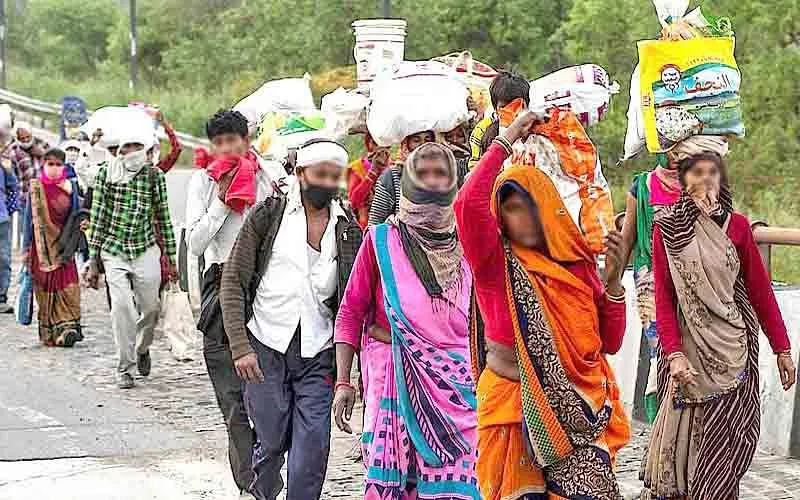The outbreak of the Covid-Pandemic has brought to spotlight the long ignored migrant workers, making them visible. While Lockdown and many other services were designated to control the pandemic but this on the other hand has increased the sufferings of the migrant workers. The workers belonged to different communities, age-groups, gender, faith identities. The exclusion of migrants from different resources was somehow the limelight during the pandemic. The appearance of the invisible migrant workers was quite significant as they were moving to reach their homes, but today as we are in the fag ends of the covid times, where vaccination has become a necessity, so these workers need to get jabbed soon to prevent further the prevalence of the disease. The Indian workforce contains 400 million people working in the informal sector, where 81% are contributing to the informal sector. Around 450 million internal migrants make 92 percent of the workforce in India and it seems to be neglected and Globally more than 700 million migrants encounter the probability of the perils of working despite health crisis. The Economic Survey 2020-2021 noted that lockdown has an inevitable impact on the vulnerable and the informal sectors, despite the other sectors as a whole.
Recently the portal on Tribal migration was launched which portrayed the movement of tribals launched by Ministry of Tribal Affairs, which will include demographic profile, livelihood options, skill-mapping and migration pattern, The universal pandemic has somehow made the issues of tribal migration pertinent which became a major concern in these times. The tribal population migration is distress driven and in unsafe conditions. This Shram Shakti gateway will vividly address the data gap and empower the tribal migrants, as they lack awareness to different issues and entitlements and in some way the way-out might make them capable enough to enhance their rights and provide them social security.
In Koraput district Odisha , Lakshmipur block as many tribal migrants were residing have voiced how the pandemic and lockdown has brought a lot of emerging crisis, somehow their basic rights, working and living conditions were affected and they had been encountering lot more problems due to the lack of wages and their social well being was at stake.
According to the World Bank, in just a few days of the lockdown, around 60,000 people had moved from urban centres to rural areas (Economic Times, 2020), The corona pandemic has severely affected the migrant workers. Stranded Workers Action Network estimated that 50% of workers had groceries left for less than a day; 74% had less than half their daily wages for survival for the rest of the pandemic period; and 89% were not paid by their employers at all during the covid lockdown times.
The Atma-Nirvar Bharat (2020) was somewhat a visionary hope for self sufficient India and reminds the importance of Amartya Sen’s theory of development which identifies migrants/ stranded migrants so that no one remains ignored or eliminated. It supported and empowered the migrant workers, empowering them could enrich home and host states, extension of provision of free food grains to those who do not hold public distribution system (PDS) cards under the purview of state and centre. The One Nation, One Ration Card dynamism, under which a ration card holder will be able to draw the allocated ration from anyplace in the country, notwithstanding of where the person belongs to.
The Niti Aayog’s Draft Policy on migrant workers highlighted some of the most pressing problems tormenting the migrant labourers: gaps in existing legislations manufactured to protect the labourers from exploitation; the absence of a governance approach towards capability building; lack of development in home states and acquiring dignified, lucrative jobs that will encourage them to migrate in the first place, as migration is necessary for the development of the economy. The draft outlines suggestions to address the problem of migrant’s .For instance, given the deficiencies pertinent to the Inter State Migrant Workers Act, 1979, an comprehensive law that would protect the rights of all migrant workers including children, women and aged population and form the legal basis for building a social security system. The exploitation faced by the migrant labourers ranging from trafficking, many social problems like lack of access to basic entitlements was denied, child marriage and domestic violence and various forms of exploitation and social menaces were prevalent during these times. Mass immunization of migrant workers, their children should be made a first priority to protect their rights and following adequate sanitary measures could limit the stigmatization process.
However the pandemic has reflected the migrant’s plight as a major concern and was a matter of international attention, the migrant’s vulnerability, precarity and agency. There is an elevated need to stop all forms of atrocities like xenophobia against the migrant workers, there is also a requirement of a right based agency to survive, right to live, adequate vaccination, also a need for effective migration governance and democratization of migrant laws to make the migrant workers situations feasible, protecting their human rights and reimagining an egalitarian society.
Dr. Nupur Pattanaik teaches Sociology at Department of Sociology, Central University of Odisha, Koraput, specialises in gender and migration.






